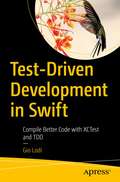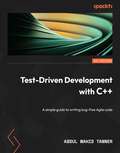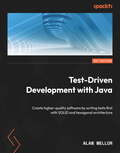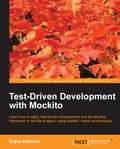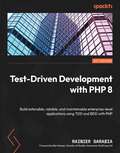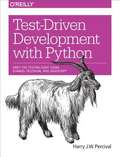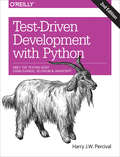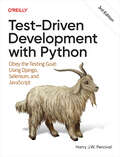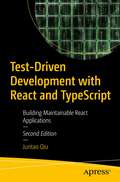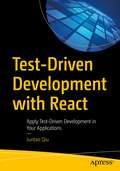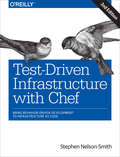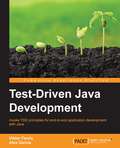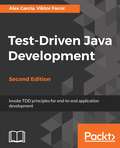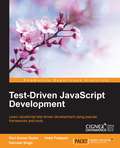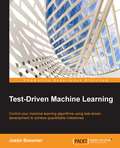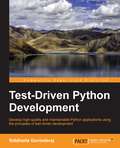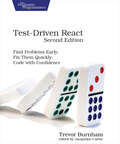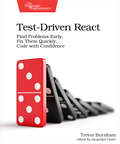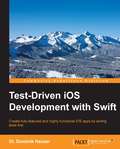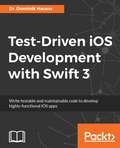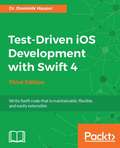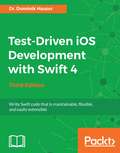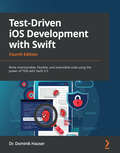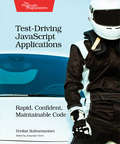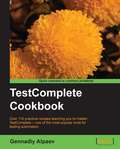- Table View
- List View
Test-Driven Development in Swift: Compile Better Code with XCTest and TDD
by Gio LodiLeverage Swift to practice effective and efficient test-driven development (TDD) methodology. Software testing and TDD are evergreen programming concepts—yet Swift developers haven't widely adopted them. What's needed is a clear roadmap to learn and adopt TDD in the Swift world. Over the past years, Apple has invested in XCTest and Xcode's testing infrastructure, making testing a new top priority in their ecosystem. Open-source libraries such as Quick and Nimble have also reached maturity. The tools are there. This book will show you how to wield them. TDD has much more to offer than catching bugs. With this book, you’ll learn a philosophy for building software. TDD enables engineers to solve problems incrementally, writing only as much code as necessary. By decomposing big problems into small steps, you can move along at a fast pace, always making visible progress. Participate in the test-driven development journey by building a real iOS application and incorporating new concepts through each chapter. The book's concepts will emerge as you figure out ways to use tests to drive the solutions to the problems of each chapter. Through the TDD of a single application, you’ll be introduced to all the staples and advanced concepts of the craft, understand the trade offs each technique offers, and review an iterative process of software development. Test-Driven Development in Swift provides the path for a highly efficient way to make amazing apps.What You'll LearnWrite tests that are easy to maintainLook after an ever-growing test suiteBuild a testing vocabulary that can be applied outside the Swift worldSee how Swift programming enhances the TDD flow seen in dynamic languages Discover how compiler errors can provide the same helpful guidance as failing tests doWho This Book Is ForMid-level developers keen to write higher quality code and improve their workflows. Also, developers that have already been writing tests but feel they are not getting the most out of them.
Test-Driven Development with C++: A simple guide to writing bug-free Agile code
by Abdul Wahid TannerLearn how to write a simple testing framework and extend it to drive the design of your logging libraryKey FeaturesLearn how to solve various challenges when testing in C++ with the help of effective solutionsDevelop a logging library with enhancementsDrive better code designs with effective testsBook DescriptionModern, standard C++ is all that is needed to create a small and practical testing framework that will improve the design of any project. This allows you to think about how the code will be used, which is the first step in designing intuitive interfaces. TDD is a modern balanced software development approach that helps to create maintainable applications, provide modularity in design, and write minimal code that drastically reduces defects. With the help of this book, you'll be able to continue adding value when designs need to change by ensuring that the changes don't break existing tests. In this book, developers working with test-driven development (TDD) will be able to put their knowledge to work by writing a simple testing framework and then using it to drive the design of a logging library. The book will help you enhance your software development skills with test cases. You'll understand how to design and implement test cases. The chapters will also show you how to utilize the TDD approach to be more productive in software development than attempting to code in large unstructured steps. By the end of this book, you'll have gained knowledge of TDD and testing and also built a working logging library.What you will learnUnderstand how to develop software using TDDKeep the code for the system as error-free as possibleRefactor and redesign code confidentlyCommunicate the requirements and behaviors of the code with your teamUnderstand the differences between unit tests and integration testsUse TDD to create a minimal viable testing frameworkWho this book is forThis book is for C++ developers already familiar with and using C++ for daily tasks who want to improve their skillset. You don't need to be an expert but you should already have some knowledge of modern C++ and how to use templates to get the most out of this book.
Test-Driven Development with Java: Create higher-quality software by writing tests first with SOLID and hexagonal architecture
by Alan MellorDrive development with automated tests and gain the confidence you need to write high-quality softwareKey FeaturesGet up and running with common design patterns and TDD best practicesLearn to apply the rhythms of TDD – arrange, act, assert and red, green, refactorUnderstand the challenges of implementing TDD in the Java ecosystem and build a planBook DescriptionTest-driven development enables developers to craft well-designed code and prevent defects. It's a simple yet powerful tool that helps you focus on your code design, while automatically checking that your code works correctly. Mastering TDD will enable you to effectively utilize design patterns and become a proficient software architect.The book begins by explaining the basics of good code and bad code, bursting common myths, and why Test-driven development is crucial. You'll then gradually move toward building a sample application using TDD, where you'll apply the two key rhythms -- red, green, refactor and arrange, act, assert. Next, you'll learn how to bring external systems such as databases under control by using dependency inversion and test doubles. As you advance, you'll delve into advanced design techniques such as SOLID patterns, refactoring, and hexagonal architecture. You'll also balance your use of fast, repeatable unit tests against integration tests using the test pyramid as a guide. The concluding chapters will show you how to implement TDD in real-world use cases and scenarios and develop a modern REST microservice backed by a Postgres database in Java 17.By the end of this book, you'll be thinking differently about how you design code for simplicity and how correctness can be baked in as you go.What you will learnDiscover how to write effective test cases in JavaExplore how TDD can be incorporated into crafting softwareFind out how to write reusable and robust code in JavaUncover common myths about TDD and understand its effectivenessUnderstand the accurate rhythm of implementing TDDGet to grips with the process of refactoring and see how it affects the TDD processWho this book is forThis book is for expert Java developers and software architects crafting high-quality software in Java. Test-Driven Development with Java can be picked up by anyone with a strong working experience in Java who is planning to use Test-driven development for their upcoming projects.
Test-Driven Development with Mockito
by Sujoy AcharyaThis book is a hands-on guide, full of practical examples to illustrate the concepts of Test Driven Development.If you are a developer who wants to develop software following Test Driven Development using Mockito and leveraging various Mockito features, this book is ideal for you. You don't need prior knowledge of TDD, Mockito, or JUnit. It is ideal for developers, who have some experience in Java application development as well as a basic knowledge of unit testing, but it covers the basic fundamentals of TDD and JUnit testing to get you acquainted with these concepts before delving into them.
Test-Driven Development with PHP 8: Build extensible, reliable, and maintainable enterprise-level applications using TDD and BDD with PHP
by Rainier Sarabia Ben HansenA PHP developer's practical guide to planning, writing, and deploying maintainable and extensible software solutions with automated tests in a well-structured wayKey FeaturesLearn to organize and translate business requirements into maintainable softwareMinimize regressions and bugs while releasing new features or bug fixesBuild maintainable applications using SOLID principlesBook DescriptionPHP web developers end up building complex enterprise projects without prior experience in test-driven and behavior-driven development which results in software that's complex and difficult to maintain. This step-by-step guide helps you manage the complexities of large-scale web applications. It takes you through the processes of working on a project, starting from understanding business requirements and translating them into actual maintainable software, to automated deployments. You'll learn how to break down business requirements into workable and actionable lists using Jira. Using those organized lists of business requirements, you'll understand how to implement behavior-driven development (BDD) and test-driven development (TDD) to start writing maintainable PHP code. You'll explore how to use the automated tests to help you stop introducing regressions to an application each time you release code by using continuous integration. By the end of this book, you'll have learned how to start a PHP project, break down the requirements, build test scenarios and automated tests, and write more testable and maintainable PHP code. By learning these processes, you'll be able to develop more maintainable, and reliable enterprise PHP applications.What you will learnUnderstand how to start a software projectDiscover how to use Jira as a tool to organize your tasksExplore when and how to write unit, integration, and functional tests using PHPUnitWrite behavior-driven tests using BehatApply SOLID principles to help you write more testable codeGet the most out of your automated tests by using continuous integrationUse continuous delivery to help you prepare your application for deploymentWho this book is forThis book is for PHP software developers looking to implement TDD and BDD in their projects. An understanding of object-oriented programming is required to get the most out of this book. Professional software development experience will also be beneficial to understand real-life business cases.
Test-Driven Development with Python
by Harry J.W. PercivalBy taking you through the development of a real web application from beginning to end, this hands-on guide demonstrates the practical advantages of test-driven development (TDD) with Python. You'll learn how to write and run tests before building each part of your app, and then develop the minimum amount of code required to pass those tests. The result? Clean code that works.In the process, you'll learn the basics of Django, Selenium, Git, jQuery, and Mock, along with current web development techniques. If you're ready to take your Python skills to the next level, this book clearly demonstrates how TDD encourages simple designs and inspires confidence.Dive into the TDD workflow, including the unit test/code cycle and refactoringUse unit tests for classes and functions, and functional tests for user interactions within the browserLearn when and how to use mock objects, and the pros and cons of isolated vs. integrated testsTest and automate your deployments with a staging serverApply tests to the third-party plugins you integrate into your siteUse a Continuous Integration environment to run your tests automatically
Test-Driven Development with Python: Obey the Testing Goat: Using Django, Selenium, and JavaScript
by Harry PercivalBy taking you through the development of a real web application from beginning to end, the second edition of this hands-on guide demonstrates the practical advantages of test-driven development (TDD) with Python. You’ll learn how to write and run tests before building each part of your app, and then develop the minimum amount of code required to pass those tests. The result? Clean code that works.In the process, you’ll learn the basics of Django, Selenium, Git, jQuery, and Mock, along with current web development techniques. If you’re ready to take your Python skills to the next level, this book—updated for Python 3.6—clearly demonstrates how TDD encourages simple designs and inspires confidence.Dive into the TDD workflow, including the unit test/code cycle and refactoringUse unit tests for classes and functions, and functional tests for user interactions within the browserLearn when and how to use mock objects, and the pros and cons of isolated vs. integrated testsTest and automate your deployments with a staging serverApply tests to the third-party plugins you integrate into your siteRun tests automatically by using a Continuous Integration environmentUse TDD to build a REST API with a front-end Ajax interface
Test-Driven Development with Python: Obey the Testing Goat: Using Django, Selenium, and JavaScript
by Harry PercivalThe third edition of this trusted guide demonstrates the practical advantages of test-driven development (TDD) with Python and describes how to develop a real web application. You'll learn how to write and run tests before building each part of your app and then develop the minimum amount of code required to pass those tests. The result? Clean code that works. In the process, author Harry Percival teaches software and web developers the basics of Django, Selenium, Git, JavaScript, and Mock libraries, along with current web development techniques. This book—updated for Python 3.14 and Django 4—clearly demonstrates how TDD encourages simple designs and inspires confidence. Fully updated, this third edition addresses: The TDD workflow, including the unit test/code cycle and refactoring Unit tests for classes and functions and functional tests for user interactions within the browser Mock objects and the pros and cons of isolated versus integrated tests Testing and automation of deployments with a staging server Tests applied to the third-party plug-ins you integrate into your site Automatic tests using a continuous integration environment Using TDD to build a REST API with a JavaScript frontend interface
Test-Driven Development with React and TypeScript: Building Maintainable React Applications
by Juntao QiuApply test-driven principles to create scalable and maintainable React applications. This book covers a wide range of topics, including setting up a testing environment and utilizing popular testing frameworks like Cypress, Jest, and the React Testing Library. It also delves into valuable refactoring techniques, as well as enhancing code maintainability and readability. What sets this comprehensive guide apart is its end-to-end project simulation, showcasing how TDD can be employed to build a complete application called "Bookish." Test-Driven Development with React and TypeScript elevates its code examples by leveraging TypeScript, the predominant language in modern frontend development, offering you a deeper understanding of how TDD principles can be applied to React projects. Furthermore, all code examples have been carefully revised and updated for this edition, incorporating reader feedback and reflecting current industry standards.After completing this book, you have the knowledge and skills necessary to develop high quality and scalable React applications. What You Will Learn Master essential refactoring techniques to enhance code qualityEmploy modern practices for writing maintainable React code, including testing and product implementationGain practical experience applying test-driven development (TDD) principles to real-world projects Craft high quality, scalable, and maintainable React applications using TDD principles and techniques Who This Book Is ForWeb application developers who wants to learn how to write high quality code using test-driven development.
Test-Driven Development with React: Apply Test-Driven Development in Your Applications
by Juntao QiuLearn to use accelerated test-driven development (TDD) to build a React application from scratch. This book explains how your React components will be integrated, and how to refactor code to make it more concise and flexible. With TDD you can develop a robust test suite to catch bugs, and develop modular, flexible code. Applying your understanding of how HTML, CSS, and JavaScript work in the browser you'll build a web application called Bookish using TDD and mainstream React stack technologies such as React, React-router, and Redux. Using higher code quality you'll be able to write executable documentation using Cucumber. This is just one of many essentials in maintaining a practical TDD workflow in your daily workload. Test-Driven Development with React highlights best practices and design patterns that will enable you to write more maintainable and reusable React components. What You'll Learn Manage your application’s state using ReduxEmploy professional techniques for backend servicesUse Cypress as an end-to-end testing frameworkUtilize React-testing-library for unit and integration tests Who This Book Is For Ideal for web application developers who wants to learn how to write high quality code using Test-Driven Development.
Test-Driven Infrastructure with Chef: Bring Behavior-Driven Development to Infrastructure as Code
by Stephen Nelson-SmithSince Test-Driven Infrastructure with Chef first appeared in mid-2011, infrastructure testing has begun to flourish in the web ops world. In this revised and expanded edition, author Stephen Nelson-Smith brings you up to date on this rapidly evolving discipline, including the philosophy driving it and a growing array of tools. You’ll get a hands-on introduction to the Chef framework, and a recommended toolchain and workflow for developing your own test-driven production infrastructure.Several exercises and examples throughout the book help you gain experience with Chef and the entire infrastructure-testing ecosystem. Learn how this test-first approach provides increased security, code quality, and peace of mind.Explore the underpinning philosophy that infrastructure can and should be treated as codeBecome familiar with the MASCOT approach to test-driven infrastructureUnderstand the basics of test-driven and behavior-driven development for managing changeDive into Chef fundamentals by building an infrastructure with real examplesDiscover how Chef works with tools such as Virtualbox and VagrantGet a deeper understanding of Chef by learning Ruby language basicsLearn the tools and workflow necessary to conduct unit, integration, and acceptance tests
Test-Driven Java Development
by Viktor Farcic Alex GarciaInvoke TDD principles for end-to-end application development with Java About This Book * Explore the most popular TDD tools and frameworks and become more proficient in building applications * Create applications with better code design, fewer bugs, and higher test coverage, enabling you to get them to market quickly * Implement test-driven programming methods into your development workflows Who This Book Is For If you're an experienced Java developer and want to implement more effective methods of programming systems and applications, then this book is for you. What You Will Learn * Explore the tools and frameworks required for effective TDD development * Perform the Red-Green-Refactor process efficiently, the pillar around which all other TDD procedures are based * Master effective unit testing in isolation from the rest of your code * Design simple and easily maintainable codes by implementing different techniques * Use mocking frameworks and techniques to easily write and quickly execute tests * Develop an application to implement behaviour-driven development in conjunction with unit testing * Enable and disable features using Feature Toggles In Detail Test-driven development (TDD) is a development approach that relies on a test-first procedure that emphasises writing a test before writing the necessary code, and then refactoring the code to optimize it. The value of performing TDD with Java, one of the most established programming languages, is to improve the productivity of programmers, the maintainability and performance of code, and develop a deeper understanding of the language and how to employ it effectively. Starting with the basics of TDD and reasons why its adoption is beneficial, this book will take you from the first steps of TDD with Java until you are confident enough to embrace the practice in your day-to-day routine. You'll be guided through setting up tools, frameworks, and the environment you need, and will dive right in to hands-on exercises with the goal of mastering one practice, tool, or framework at a time. You'll learn about the Red-Green-Refactor procedure, how to write unit tests, and how to use them as executable documentation. With this book you'll also discover how to design simple and easily maintainable code, work with mocks, utilise behaviour-driven development, refactor old legacy code, and release a half-finished feature to production with feature toggles. You will finish this book with a deep understanding of the test-driven development methodology and the confidence to apply it to application programming with Java. Style and approach An easy-to-follow, hands-on guide to building applications through effective coding practices. This book covers practical examples by introducing different problems, each one designed as a learning exercise to help you understand each aspect of TDD.
Test-Driven Java Development, Second Edition: Invoke TDD principles for end-to-end application development, 2nd Edition
by Viktor Farcic Alex GarciaThis book will teach the concepts of test driven development in Java so you can build clean, maintainable and robust codeKey Features Explore the most popular TDD tools and frameworks and become more proficient in building applications Create applications with better code design, fewer bugs, and higher test coverage, enabling you to get them to market quickly Implement test-driven programming methods into your development workflowsBook DescriptionTest-driven development (TDD) is a development approach that relies on a test-first procedure that emphasizes writing a test before writing the necessary code, and then refactoring the code to optimize it.The value of performing TDD with Java, one of the longest established programming languages, is to improve the productivity of programmers and the maintainability and performance of code, and develop a deeper understanding of the language and how to employ it effectively.Starting with the basics of TDD and understanding why its adoption is beneficial, this book will take you from the first steps of TDD with Java until you are confident enough to embrace the practice in your day-to-day routine.You'll be guided through setting up tools, frameworks, and the environment you need, and we will dive right into hands-on exercises with the goal of mastering one practice, tool, or framework at a time. You'll learn about the Red-Green-Refactor procedure, how to write unit tests, and how to use them as executable documentation.With this book, you'll also discover how to design simple and easily maintainable code, work with mocks, utilize behavior-driven development, refactor old legacy code, and release a half-finished feature to production with feature toggles.You will finish this book with a deep understanding of the test-driven development methodology and the confidence to apply it to application programming with Java.What you will learn Explore the tools and frameworks required for effective TDD development Perform the Red-Green-Refactor process efficiently, the pillar around which all other TDD procedures are based Master effective unit testing in isolation from the rest of your code Design simple and easily maintainable code by implementing different techniques Use mocking frameworks and techniques to easily write and quickly execute tests Develop an application to implement behavior-driven development in conjunction with unit testing Enable and disable features using feature togglesWho this book is forIf you're an experienced Java developer and want to implement more effective methods of programming systems and applications, then this book is for you.
Test-Driven JavaScript Development
by Harmeet Singh Ravi Kumar Gupta Hetal PrajapatiLearn JavaScript test-driven development using popular frameworks and tools About This Book * Learn the life cycle of TDD and its importance in real-world application * Gain knowledge about popular tools and analyze features, syntax, and how they help in JavaScript testing * Implement test-driven programming exercises using the practical code examples Who This Book Is For If you have an intermediate knowledge of HTML, CSS, and JavaScript and want to learn how and why the test-driven development approach is better for your assignments, then this book is for you. What You Will Learn * Basic TDD fundamentals, life cycle, and benefits * Become acquainted with the concepts and elements of unit testing and writing basic unit tests for JavaScript * Understand the way JsUnit, Qunit, Karma and DalekJs work * Use the Jasmine framework * Interpret feature detection and devise tests specific to cross-browser compatibility * Integrate jsTestDriver with Eclipse and run tests with jsTestDriver * Explore re-factoring, adding and notifying observers * Understand test-driven development in case of server-side JS In Detail Initially, all processing used to happen on the server-side and simple output was the response to web browsers. Nowadays, there are so many JavaScript frameworks and libraries created that help readers to create charts, animations, simulations, and so on. By the time a project finishes or reaches a stable state, so much JavaScript code has already been written that changing and maintaining it further is tedious. Here comes the importance of automated testing and more specifically, developing all that code in a test-driven environment. Test-driven development is a methodology that makes testing the central part of the design process - before writing code developers decide upon the conditions that code must meet to pass a test. The end goal is to help the readers understand the importance and process of using TDD as a part of development. This book starts with the details about test-driven development, its importance, need, and benefits. Later the book introduces popular tools and frameworks like YUI, Karma, QUnit, DalekJS, JsUnit and goes on to utilize Jasmine, Mocha, Karma for advanced concepts like feature detection, server-side testing, and patterns. We are going to understand, write, and run tests, and further debug our programs. The book concludes with best practices in JavaScript testing. By the end of the book, the readers will know why they should test, how to do it most efficiently, and will have a number of versatile tests (and methods for devising new tests) to get to work immediately. Style and approach Easy-to-follow guide with suitable examples for developing JavaScript code in the test-Driven environment, with popular tools and frameworks. User experience and statements are also included to help readers make a better choice of tool for real-world projects.
Test-Driven Machine Learning
by Justin BozonierThis book is intended for data technologists (scientists, analysts, or developers) with previous machine learning experience who are also comfortable reading code in Python. You may be starting, or have already started, a machine learning project at work and are looking for a way to deliver results quickly to enable rapid iteration and improvement. Those looking for examples of how to isolate issues in models and improve them will find ideas in this book to move forward.
Test-Driven Python Development
by Siddharta GovindarajThis book is intended for Python developers who want to use the principles of test-driven development (TDD) to create efficient and robust applications. In order to get the best out of this book, you should have development experience with Python.
Test-Driven React
by Trevor BurnhamTurn your React project requirements into tests and get the feedback you need faster than ever before. Combine the power of testing, linting, and typechecking directly in your coding environment to iterate on React components quickly and fearlessly! You work in a loop: write code, get feedback, adjust. The faster you get feedback, the faster your code improves and the more effective you become as a developer. And that feedback comes from testing. The conceptual elegance of React has opened the door to a new generation of web testing: clear, expressive, and lightning fast. That makes React a perfect fit for test-driven development (TDD), a methodology in which tests are a blueprint instead of an afterthought. Each chapter presents new projects to challenge you and new tools to help you: Write fast, easy-to-understand tests with Vitest and React Testing Library.Keep your code tidy with ESLint and Prettier.Perform every task you need from a single window within VS Code.See your test output directly in your code with Wallaby.Style components in a test-friendly way with styled-components. Stay focused on what's important by running your tests continuously in the background.Generate beautiful documentation with Storybook, and update it on every commit with GitHub Actions. The second edition of Test-Driven React has been extensively revised to reflect the latest tools and techniques for React development, including TypeScript. Each chapter presents new projects to challenge you and new tools to help you find and fix type errors without even running your code. What You Need: You'll need a working knowledge of JavaScript or TypeScript, and a computer running macOS, Windows, or Linux.
Test-Driven React: Find Problems Early, Fix Them Quickly, Code with Confidence
by Trevor BurnhamYou work in a loop: write code, get feedback, iterate. The faster you get feedback, the faster you can learn and become a more effective developer. Test-Driven React helps you refine your React workflow to give you the feedback you need as quickly as possible. Write strong tests and run them continuously as you work, split complex code up into manageable pieces, and stay focused on what's important by automating away mundane, trivial tasks. Adopt these techniques and you'll be able to avoid productivity traps and start building React components at a stunning pace!
Test-Driven iOS Development with Swift
by Dr Dominik HauserCreate fully-featured and highly functional iOS apps by writing tests first About This Book • Learn test-driven principles to help you build apps with fewer bugs and better designs • Become more efficient while working with Swift to move on to your next project faster! • Learn how to incorporate all of the principles of test-driven development (TDD) in to your daily programming workflow Who This Book Is For If debugging iOS apps is a nerve-racking task for you and you are looking for a fix, this book is for you. What You Will Learn • Implement TDD in swift application development • Get to know the fundamentals, life cycle, and benefits of TDD • Explore the tools and frameworks to effectively use TDD • Develop models and controllers driven by tests • Construct the network layer using stubs • Use functional tests to ensure the app works as planned • Automate and streamline the building, analysing, testing, and archiving of your iOS apps In Detail Test-driven development (TDD) is a proven way to find software bugs early. Writing tests before your code improves the structure and maintainability of your app. Test-Driven iOS Development with Swift will help you understand the process of TDD and how it impacts your applications written in Swift. Through practical, real-world examples, you'll start seeing how to implement TDD in context. We will begin with an overview of your TDD workflow and then deep-dive into unit testing concepts and code cycles. We will showcase the workings of functional tests, which will help you improve the user interface. Finally, you will learn about automating deployments and continuous integration to run an environment. Style and approach This is an easy-to-follow example-driven tutorial, packed with lots of tips and tricks that explore TDD bit-by-bit in the process of making an iOS application.
Test-Driven iOS Development with Swift
by Dr Dominik HauserCreate fully-featured and highly functional iOS apps by writing tests first About This Book * Learn test-driven principles to help you build apps with fewer bugs and better designs * Become more efficient while working with Swift to move on to your next project faster! * Learn how to incorporate all of the principles of test-driven development (TDD) in to your daily programming workflow Who This Book Is For If debugging iOS apps is a nerve-racking task for you and you are looking for a fix, this book is for you. What You Will Learn * Implement TDD in swift application development * Get to know the fundamentals, life cycle, and benefits of TDD * Explore the tools and frameworks to effectively use TDD * Develop models and controllers driven by tests * Construct the network layer using stubs * Use functional tests to ensure the app works as planned * Automate and streamline the building, analysing, testing, and archiving of your iOS apps In Detail Test-driven development (TDD) is a proven way to find software bugs early. Writing tests before your code improves the structure and maintainability of your app. Test-Driven iOS Development with Swift will help you understand the process of TDD and how it impacts your applications written in Swift. Through practical, real-world examples, you'll start seeing how to implement TDD in context. We will begin with an overview of your TDD workflow and then deep-dive into unit testing concepts and code cycles. We will showcase the workings of functional tests, which will help you improve the user interface. Finally, you will learn about automating deployments and continuous integration to run an environment. Style and approach This is an easy-to-follow example-driven tutorial, packed with lots of tips and tricks that explore TDD bit-by-bit in the process of making an iOS application.
Test-Driven iOS Development with Swift 4
by Dominik HauserUse test-driven approach to develop highly-functional iOS apps with Swift 4 and Xcode 9 About This Book A practical guide to writing effective, organized, and clean code that works well Learn test-driven principles to help you build better-designed apps with fewer bugs A comprehensive overview of the techniques available for TDD in Swift Who This Book Is For To get the most out of this book, you will need some prior experience with Swift application development. You may have already heard about Test-Driven Development (TDD) but you don't need any prior experience of applying it to Swift applications. What You Will Learn Implement TDD in Swift application development Find bugs before you enter code using the TDD approach Use TDD to build models, view controllers, and views Test network code with asynchronous tests and stubs Write code that is a joy to read and maintain Develop functional tests to ensure the app works as planned In Detail Test-driven development (TDD) is a proven way to find software bugs early. Writing tests before you code improves the structure and maintainability of your apps. Using TDD, in combination with Swift 4's improved syntax, means there is no longer any excuse for writing bad code. This book will help you understand the process of TDD and how to apply it to your apps written in Swift. Through practical, real-world examples, you'll learn how to implement TDD in context. You will begin with an overview of the TDD workflow and then delve into unit-testing concepts and code cycles. You will also plan and structure your test-driven iOS app, and write tests to drive the development of view controllers and helper classes. Next, you'll learn how to write tests for network code and explore how the test-driven approach—in combination with stubs—helps you write network code even before the backend component is finished. Finally, the book will guide you through the next steps to becoming a testing expert by discussing integration tests, Behavior Driven Development (BDD), open source testing frameworks, and UI Tests (introduced in Xcode 9). Style and approach Using a step-by-step approach, you will develop an entire iOS app using TDD. During the course of the book, you will explore different strategies for writing tests for models, View Controllers, and networking code.
Test-Driven iOS Development with Swift 4 - Third Edition
by Dr Dominik HauserUse test-driven approach to develop highly-functional iOS apps with Swift 4 and Xcode 9 About This Book • A practical guide to writing effective, organized, and clean code that works well • Learn test-driven principles to help you build better-designed apps with fewer bugs • A comprehensive overview of the techniques available for TDD in Swift Who This Book Is For To get the most out of this book, you will need some prior experience with Swift application development. You may have already heard about Test-Driven Development (TDD) but you don't need any prior experience of applying it to Swift applications. What You Will Learn • Implement TDD in Swift application development • Find bugs before you enter code using the TDD approach • Use TDD to build models, view controllers, and views • Test network code with asynchronous tests and stubs • Write code that is a joy to read and maintain • Develop functional tests to ensure the app works as planned In Detail Test-driven development (TDD) is a proven way to find software bugs early. Writing tests before you code improves the structure and maintainability of your apps. Using TDD, in combination with Swift 4's improved syntax, means there is no longer any excuse for writing bad code. This book will help you understand the process of TDD and how to apply it to your apps written in Swift. Through practical, real-world examples, you'll learn how to implement TDD in context. You will begin with an overview of the TDD workflow and then delve into unit-testing concepts and code cycles. You will also plan and structure your test-driven iOS app, and write tests to drive the development of view controllers and helper classes. Next, you'll learn how to write tests for network code and explore how the test-driven approach—in combination with stubs—helps you write network code even before the backend component is finished. Finally, the book will guide you through the next steps to becoming a testing expert by discussing integration tests, Behavior Driven Development (BDD), open source testing frameworks, and UI Tests (introduced in Xcode 9). Style and approach Using a step-by-step approach, you will develop an entire iOS app using TDD. During the course of the book, you will explore different strategies for writing tests for models, View Controllers, and networking code.
Test-Driven iOS Development with Swift: Write maintainable, flexible, and extensible code using the power of TDD with Swift 5.5, 4th Edition
by Dr. Dominik HauserBuild robust applications using TDD with Swift 5.5 and become a TDD expert by writing tests for view controller, views, network code, and even SwiftUI viewKey FeaturesBuild a complete iOS app using test-driven developmentExplore testing view controllers, table views, navigation, and network codeLearn how to write tests for Combine and SwiftUI codeBook DescriptionTest-driven development (TDD) is a proven way to find software bugs earlier on in software development. Writing tests before you code improves the structure and maintainability of your apps, and so using TDD in combination with Swift 5.5's improved syntax leaves you with no excuse for writing bad code.Developers working with iOS will be able to put their knowledge to work with this practical guide to TDD in iOS. This book will help you grasp the fundamentals and show you how to run TDD with Xcode. You'll learn how to test network code, navigate between different parts of the app, run asynchronous tests, and much more. Using practical, real-world examples, you'll begin with an overview of the TDD workflow and get to grips with unit testing concepts and code cycles. You'll then develop an entire iOS app using TDD while exploring different strategies for writing tests for models, view controllers, and networking code. Additionally, you'll explore how to test the user interface and business logic of iOS apps and even write tests for the network layer of the sample app.By the end of this TDD book, you'll be able to implement TDD methodologies comfortably in your day-to-day development for building scalable and robust applications.What you will learnImplement TDD in Swift application developmentDetect bugs before you run code using the TDD approachUse TDD to build models, view controllers, and viewsTest network code with asynchronous tests and stubsWrite code that's a joy to read and maintainDesign functional tests to suit your software requirementsDiscover scenarios where TDD should be applied and avoidedWho this book is forThis book is for iOS developers looking to apply TDD to build maintainable and scalable applications. Intermediate-level developers with Swift application development experience will be able to make the most out of this book. Prior experience of applying TDD to Swift applications is not required.
Test-Driving JavaScript Applications: Rapid, Confident, Maintainable Code
by Venkat SubramaniamDebunk the myth that JavaScript is not easily testable. Whether you use Node.js, Express, MongoDB, jQuery, AngularJS, or directly manipulate the DOM, you can test-drive JavaScript. Learn the craft of writing meaningful, deterministic automated tests with Karma, Mocha, and Chai. Test asynchronous JavaScript, decouple and properly mock out dependencies, measure code coverage, and create lightweight modular designs of both server-side and client-side code. Your investment in writing tests will pay high dividends as you create code that's predictable and cost-effective to change.Design and code JavaScript applications with automated tests. Writing meaningful tests is a skill that takes learning, some unlearning, and a lot of practice, and with this book, you'll hone that skill. Fire up the editor and get hands-on through practical exercises for effective automated testing and designing maintainable, modular code.Start by learning when and why to do manual testing vs. automated verification. Focus tests on the important things, like the pre-conditions, the invariants, complex logic, and gnarly edge cases. Then begin to design asynchronous functions using automated tests. Carefully decouple and mock out intricate dependencies such as the DOM, geolocation API, file and database access, and Ajax calls to remote servers.Step by step, test code that uses Node.js, Express, MongoDB, jQuery, and AngularJS. Know when and how to use tools such as Chai, Istanbul, Karma, Mocha, Protractor, and Sinon. Create tests with minimum effort and run them fast without having to spin up web servers or manually edit HTML pages to run in browsers. Then explore end-to-end testing to ensure all parts are wired and working well together.Don't just imagine creating testable code, write it.What You Need:A computer with a text editor and your favorite browser. The book provides instructions to install the necessary automated testing-related tools.
TestComplete Cookbook
by Gennadiy AlpaevIf you are a software tester or a programmer who is involved with testing automation using TestComplete, this book is ideal for you! You will be introduced to the very basics of using the tool, as well as polish any previously gained knowledge in using the tool. If you are already aware of programming basics, but are new to TestComplete, you will also be able to quickly learn the concepts through selected examples that are easily scalable for your specific needs.
